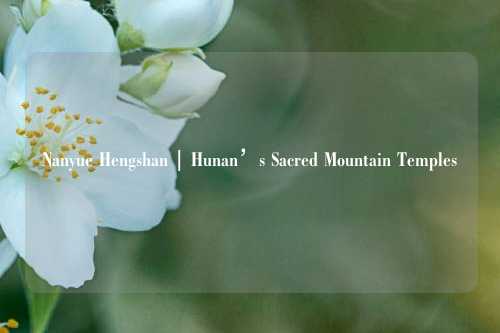Nanyue Hengshan | Hunan’s Sacred Mountain Temples
A Mountain of Spiritual Significance
Nanyue Hengshan, one of China’s Five Great Mountains, is a place of deep spiritual and historical significance. Located in Hunan Province, this mountain range has long been a destination for pilgrims, scholars, and nature enthusiasts. The area is known for its rich cultural heritage, breathtaking peaks, and centuries-old temples that stand as testaments to China’s religious traditions. Rising above mist-covered forests, the mountain’s beauty has inspired poets and monks for generations, making it one of the most visited sacred sites in the country.
Ancient Temples and Religious Traditions
The mountain is home to numerous temples, each with its own history and role in Buddhist and Taoist traditions. Among them, Nanyue Temple stands out as the most significant. Originally built during the Tang Dynasty, this temple complex is one of the largest in southern China. Its grand halls, intricate carvings, and peaceful courtyards attract both worshippers and travelers seeking to immerse themselves in the region’s spiritual atmosphere.

Another significant site is the Zhurong Peak Temple, located near the highest point of the mountain. Dedicated to Zhurong, the God of Fire in Chinese mythology, this temple is a place of both prayer and contemplation. Pilgrims often climb the steep stone steps to pay their respects and take in the stunning views of the surrounding landscape. The combination of religious devotion and natural beauty makes this a deeply moving experience for visitors.
Scenic Peaks and Forested Trails
Hengshan is not only a center of religious activity but also a paradise for nature lovers. The mountain range features 72 peaks, each offering distinct landscapes and breathtaking views. The most famous is Zhurong Peak, standing at 1,300 meters above sea level. The climb to the top is a rewarding journey, as travelers pass through ancient forests, hidden waterfalls, and stone pathways carved into the mountainside.
For those who prefer a more leisurely experience, the mountain also offers well-maintained trails that lead through pine-covered slopes and misty valleys. These paths are often lined with stone tablets bearing inscriptions from scholars and poets who visited the mountain in ancient times. Walking these trails provides not only a sense of peace but also a glimpse into China’s literary and philosophical traditions.
Seasonal Beauty and Ever-Changing Landscapes
Hengshan’s scenery transforms with the seasons, offering a different experience throughout the year. In spring, cherry blossoms and azaleas cover the mountainsides in delicate shades of pink and red. The summer months bring lush greenery and a refreshing escape from the heat, as the higher elevations remain cool even in the warmest weather.
Autumn is particularly stunning, as the forests turn golden and crimson, creating a breathtaking contrast against the deep blue sky. This season is also a popular time for visitors, as the crisp air and clear skies make for ideal hiking conditions. Winter blankets the peaks in snow, adding a mystical quality to the landscape. The temples, partially covered in frost, take on an ethereal beauty that draws photographers and seekers of tranquility.
A Destination for Pilgrimage and Reflection
For centuries, Nanyue Hengshan has been a place of pilgrimage for those seeking spiritual enlightenment. Buddhist monks, Taoist priests, and Confucian scholars have all walked its paths, leaving behind a legacy of devotion and wisdom. Even today, the mountain remains a site for religious ceremonies, where large gatherings take place during special festivals.
One of the most important events is the annual Nanyue Temple Fair, held during the Lunar New Year. During this time, thousands of pilgrims come to offer incense, pray for blessings, and take part in traditional performances. The atmosphere is filled with the sound of chanting monks, ringing bells, and the scent of burning incense, creating a deeply immersive experience.
Local Cuisine and Specialty Foods
After a long day of exploring the mountain, visitors can enjoy the flavors of local Hunan cuisine, known for its bold and spicy dishes. A specialty of the region is Nanyue tofu, a delicately prepared dish often served with fresh mountain vegetables. Another popular choice is stewed bamboo shoots, harvested from the surrounding forests and cooked with local spices.
For those looking for a more traditional meal, vegetarian temple food is also available. Many of the mountain’s temples serve simple but delicious meals made from fresh ingredients, following Buddhist dietary customs. These meals offer a glimpse into the monastic way of life, emphasizing balance and harmony in every bite.
Travel Tips and Best Times to Visit
The best time to visit Nanyue Hengshan depends on personal preferences. Spring and autumn are the most popular seasons, offering pleasant temperatures and stunning natural scenery. Summer is also a good time for those seeking a cool retreat, while winter provides a peaceful atmosphere with fewer crowds.
Visitors should wear comfortable shoes, as much of the exploration involves walking or climbing stone steps. Bringing a light jacket is also recommended, as temperatures can be lower at higher altitudes. Respecting local customs is important, especially when visiting temples—dressing modestly and maintaining a quiet demeanor will help ensure a respectful experience.
A Journey Through Nature and History
Nanyue Hengshan is more than just a mountain; it is a place where history, religion, and nature come together. Whether climbing its peaks, exploring its temples, or simply enjoying the tranquility of its forests, visitors will find a deep sense of connection to something greater than themselves. This sacred site continues to be a source of inspiration for those who seek peace, knowledge, and a deeper understanding of China’s spiritual traditions.
















